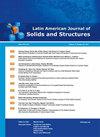A study of TLCD parameters for structural vibration mitigation
IF 1.1
4区 工程技术
Q3 ENGINEERING, CIVIL
引用次数: 0
Abstract
In this article, the efficiency of the tuned liquid column damper (TLCD) in reducing structural vibration is analyzed. The analysis by numerical methods and by analytical methods is adopted in the search for the ideal parameters for the liquid column. The equivalent linear model is considered for the U-shaped liquid column equation of motion with damping resulting from an orifice. Thus, variation of TLCD parameters for different loads is investigated. Initially, for the numerical study in conjunction with the analytical formulation, a sinusoidal forcing is adopted. Subsequently, the action of an earthquake through the recorded ground accelerations is considered in the case study. Optimal TLCD parameters are presented via response map for reducing the structure's maximum permanent response to harmonic excitation and for reducing the structure's rms response to seismic excitation with wide frequency and various amplitude. The variation of the TLCD parameters presented by the response map is directly related to the force acting on the structure. However, it is verified that regardless of the acting force, there is an ideal frequency range to tune the TLCD where the greatest reductions in the primary system response are found. It appears that reducing the aspect ratio of the liquid column makes this range narrower, making the damper more sensitive to parameter variations, as well as its performance. It is also observed that the increase in the attenuator mass ratio combined with the correct tuning and damping ratios present greater reductions in structural vibration. Also, the frequency ratio is reduced with the increase of the mass ratio, while the damping rate of the liquid column increases. From the ideal liquid column parameters determined by the parametric analysis, structural response reductions of approximately 60% were achieved.TLCD结构减振参数研究
本文章由计算机程序翻译,如有差异,请以英文原文为准。
求助全文
约1分钟内获得全文
求助全文
来源期刊
CiteScore
2.80
自引率
8.30%
发文量
37
审稿时长
>12 weeks

 求助内容:
求助内容: 应助结果提醒方式:
应助结果提醒方式:


